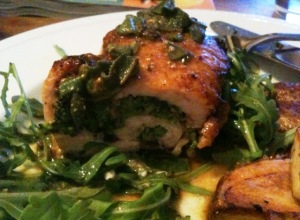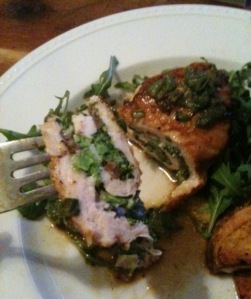Today's recipe is a throw back to my childhood, when parents and grandparents alike fought to get kids to eat their vegetables. This recipe, along with the 'carrots help you see at night' story, definitely got us into veggies. So, I picked up a small bunch of baby carrots from Fertile Crescent Farm and paired the side dish with roast pork finished with citrus/herb sauce. Here's the fix:
Candied Carrots:
1 bunch of baby carrots
2 tbsp butter
2 tbsp brown sugar
salt & pepper
canola oil
Simple, simple, simple. Preheat the oven to 350°. Chop stems off carrots, rinse and peel. In a sauté pan over medium-lo heat, add a drizzle of canola oil and the butter to melt. Add carrots and toss to coat. Cook for approximately 2-3 minutes and then add brown sugar, pinch of salt and a crack of black pepper. Toss to coat and then transfer to a non-stick roasting pan and place in oven for about 10 minutes or until a nice caramelization forms. Flip once to get all sides evenly browned. Serve warm.
and place in oven for about 10 minutes or until a nice caramelization forms. Flip once to get all sides evenly browned. Serve warm.
Pork Roast:
1 1-1.5 lb pork roast
1/4 cup extra virgin olive oil
Zest from 1/2 lemon
Juice from 1/2 lemon (or whole if it does not render enough liquid)
1 tsp capers (with liquid)
4-6 leaves fresh sage chopped
bay leaf
salt & pepper
Start by brining the roast which will make the meat moist and flavorful. In a large ziploc, add olive oil, lemon zest, juice and sliced lemon, capers, chopped sage and bay leaf. Towel dry the pork roast and season with salt and pepper. Transfer the roast to ziploc, add about 1/2 tbsp more salt, seal tightly and toss the mixture, massaging the liquid into the roast. Make sure all liquid is equally distributed around the roast and place bag into the refrigerator for 20 minutes (the acid from the lemon will start to 'cook' the meat so it should be removed from the brine within 30 minutes at the most). Remove from the refrigerator, pull the roast out, pat dry and discard the liquid. Let the meat come to room temperature.
Warm a cast-iron skillet over medium heat with about 1 tbsp olive oil. Sear the roast on all sides, about 2 minutes per side. Next, transfer the skillet with roast into an oven at 350° and roast for 15-20 minutes. The roast should rest under an aluminum foil tent for at least 5 minutes before slicing. Meat should come out juicy and slightly pink in the middle. For safety, internal temperature should be reach 160°.
over medium heat with about 1 tbsp olive oil. Sear the roast on all sides, about 2 minutes per side. Next, transfer the skillet with roast into an oven at 350° and roast for 15-20 minutes. The roast should rest under an aluminum foil tent for at least 5 minutes before slicing. Meat should come out juicy and slightly pink in the middle. For safety, internal temperature should be reach 160°.
I finished the pork with a super simple lemon sage sauce...combine 2 tbsp 2% plain Greek yogurt, 1 tsp olive oil mayonnaise, zest from 1/2 lemon, 1 tsp lemon juice and 3 leaves fresh chopped sage. Season with a little salt and spoon over sliced roast!






